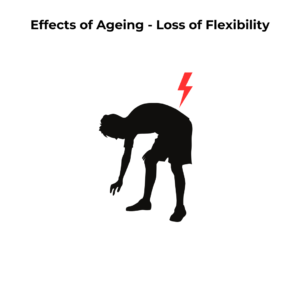Effect of Ageing on Back Health – Flexibility Loss
Effect of Ageing on Back Health - Flexibility Loss
Noticing that simple movements—like bending to tie your shoes or reaching overhead—feel tighter than they used to? That’s the sneaky effect of lost flexibility!
Understanding Flexibility Loss:
Flexibility is your body’s ability to move freely and without restriction. Flexibility is the sum total of movement permitted by joints, ligaments, tendons, muscles and fascia. Changes can occur at some or all of these tissue types.As we age, our muscles, tendons, and ligaments naturally stiffen due to decreased collagen production, reduced water content in tissues, and years of repetitive movements (or lack thereof).
This stiffness impacts posture, mobility, and back health. Tight muscles put extra strain on the spine, leading to poor alignment, increased back pain, and a higher risk of injury. If you’ve ever felt morning stiffness that takes ages to go away, you’re already experiencing the early signs of reduced flexibility!
Can We Maintain Flexibility?
Yes! With consistent directed effort, you can improve or maintain flexibility well into your later years. Here’s how:
1️⃣ Daily Stretching 🧘♂️ – A simple 5–10 minute routine focusing on your back, hips, and hamstrings can keep your spine moving freely. Try cat-cow stretches, seated hamstring stretches, and spinal twists. You-Tube is a great resource. Just find someone in your age range and preferably gender as well.
2️⃣ Stay Active 🚶♀️ – Regular movement, especially activities like yoga, pilates, and swimming, prevents muscles from tightening up. Muscles and their tendons will tend to accommodate whatever they are regularly exposed to whether you are young or old. Even young people who sit all day can develop tight hamstrings.
3️⃣ Hydrate & Fuel Your Muscles 💧🍏 – Muscles and joints need hydration and proper nutrition to stay supple. Make sure you’re drinking enough water and getting enough protein and omega-3s for tissue repair.
************** There is growing evidence to support the use of collagen peptide supplementation, in conjunction with exercise, for the management of degenerative joint disorders. Whether this will help with joint flexibility is yet to be seen. Stay tuned.
The Role of Chiropractic Care:
Chiropractic adjustments help restore proper spinal movement, which improves flexibility and reduces stiffness. We also work on muscle balance, ensuring no areas are overly tight or weak, and provide movement-based exercises to help you stay mobile for life.
Stay Flexible, Stay Independent!
Losing flexibility isn’t inevitable—it’s a sign that your body needs more movement! Prioritizing flexibility today means better mobility, fewer aches, and more freedom to do the things you love.
Want to keep moving with ease? Book an appointment today or visit our website to learn how chiropractic care can support your mobility!
